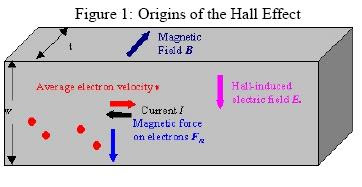diagram below. In this situation, the electrons are forced downward
by the action of the magnetic field. This causes the top of the
conductor to become positive with respect to the bottom.
This causes a downward directed electric field to develop in the
conductor. This field produces an upward force on the electrons.
Equilibrium is reached when the electric force is equal to the
magnetic force. This condition is
 satisfied when
satisfied when The induced electric field produces a potential difference across
The induced electric field produces a potential difference acrossthe conductor at a right angle to the direction of current flow.
Its magnitude is
 where w is the width of the conductor. This implies that the Hall
where w is the width of the conductor. This implies that the Hallvoltage is proportional to both the electron drift velocity and the
applied field. Note also that in this instance that the Hall-induced
potential decreases from top to bottom. Suppose instead that the
charges carrying the current had been positive. In this case, the
charges average drift velocity would be in the same direction as
the current; the magnetic force on them would again force them
in the downward direction. In this case, the Hall potential then
increases from top to bottom. The sign of the Hall voltage can
therefore be used to determine the sign of the charge
carriers in a conductor.
Source ( pdf )
http://arapaho.nsuok.edu/~bradfiel/advlab/Hall/hall-effect.pdf





